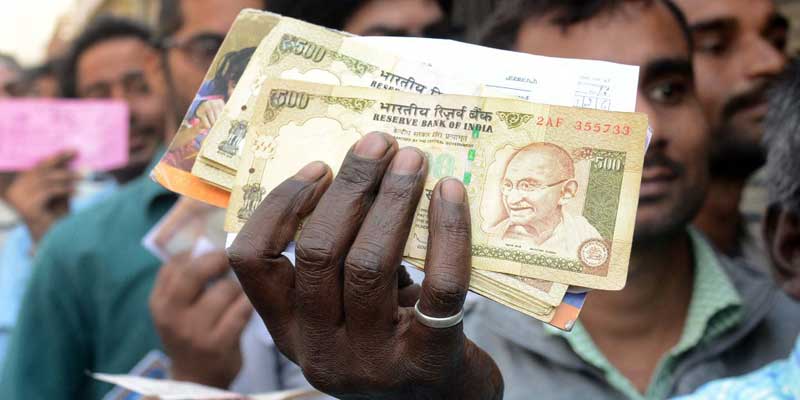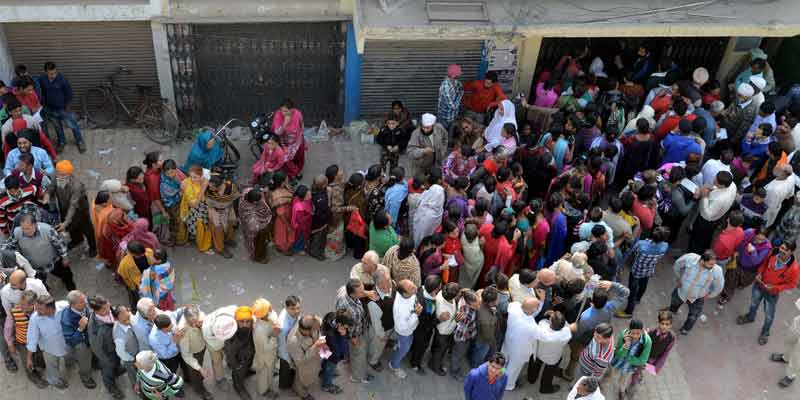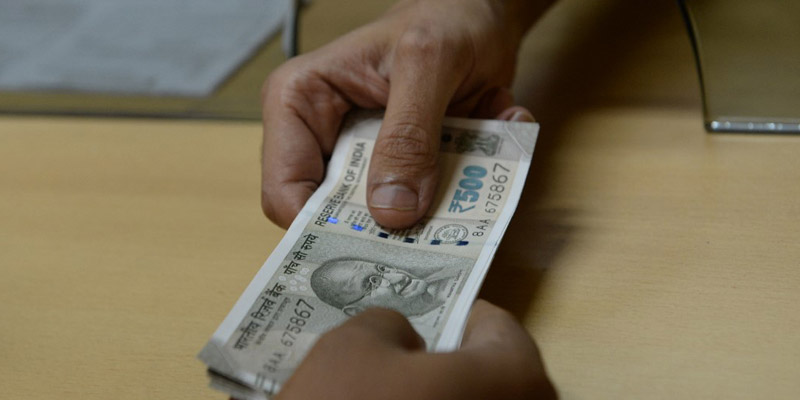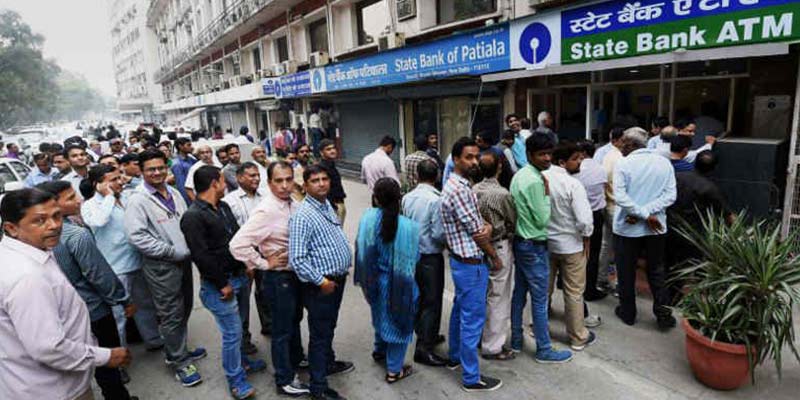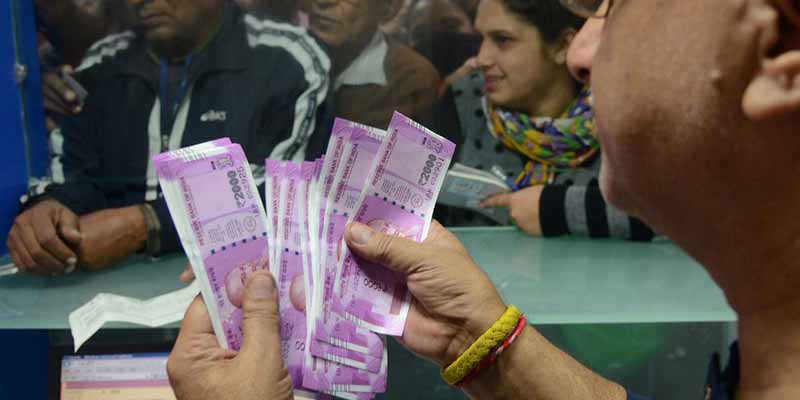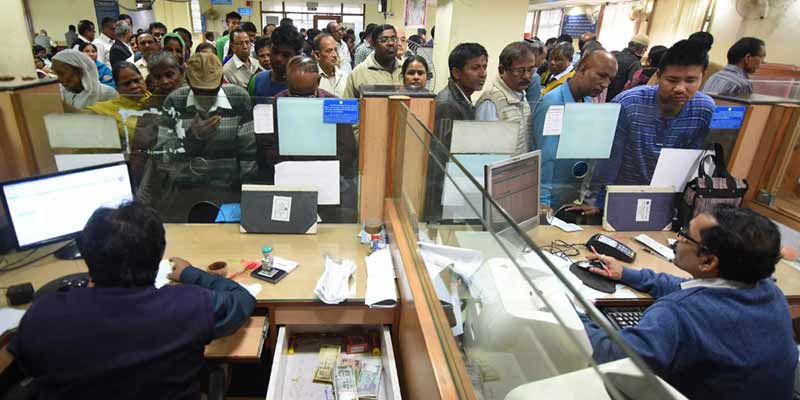- India
- Jan 04
History of demonetisation and controversy over Section 26(2) of the RBI Act
• Demonetisation was an initiative of the central government, targeted to address disparate evils, plaguing the nation’s economy, including practices of hoarding black money, counterfeiting, which in turn enable even greater evils including terror funding, drug trafficking, emergence of a parallel economy, money laundering including hawala transactions.
• The move to demonetise 86 per cent of the country’s cash in circulation representing a value of Rs 15,44,000 crore overnight in a bid to tackle black money and corruption was announced by Prime Minister Narendra Modi in a televised address on November 8, 2016.
• The sudden note ban decision sparked anxiety and panic as banks and ATMs witnessed serpentine queues with people waiting for several hours for their turn to get some cash.
• The Constitution bench of the Supreme Court upheld the legality of the Centre’s 2016 decision to ban Rs 1,000 and Rs 500 currency notes, saying the decision-making process was neither flawed nor hasty and that it is not relevant whether the stated objectives were achieved or not.
• The SC bench by a 4:1 majority also held that demonetisation is not bad in law merely because some citizens suffered through hardships. The decision does not suffer from illegality as there was consultation between the RBI and the Centre for a period of six months before the notification under challenge was issued, it said.
• The judgment came on a batch of 58 petitions challenging the demonetisation exercise.
History and previous instances of demonetisation
• First, let us try to understand the concept of demonetisation and how it has been carried out, the world over as well as in India.
What is demonetisation?
• Demonetisation is the process by which a nation’s economic unit of exchange loses its legally enforceable validity. Currencies that are terminated through the process of demonetisation are no more legally considered exchanges and have no financial value.
• Demonetisation is therefore, the process of eliminating the lawful acceptance status of a monetary unit, by withdrawal of certain kinds or denominations of existing currency from circulation.
• The currency withdrawn may be supplanted with new currency.
• The French were the first to use the term “demonetise” in the years between the years 1850-1855.
History of demonetisation in India
Demonetisation in 1946
• The first demonetisation in British India was carried out on January 12, 1946.
• To bring to realisation the first demonetisation that the country witnessed, an Ordinance was promulgated by the government on January 12, 1946.
• According to a report in the History of the Reserve Bank of India, the RBI authorities were not enthusiastic about the move. It appears that in spite of the opposition by C.D. Deshmukh, the then governor of the RBI, the government went ahead with the move and issued an ordinance on January 12, 1946.
• The Ordinance demonetised currency notes of Rs 500, Rs 1,000 and Rs 10,000 which were in circulation, primarily to check the unaccounted hoarding of money, with a directive that they could be exchanged for reissued bank notes, within ten days.
• By the end of 1947, out of a total of Rs 143.97 crore of high denomination notes, notes of the value of Rs 134.9 crore had been exchanged. Thus, notes worth Rs 9.07 crore went out of circulation or not exchanged.
• It is said that this exercise turned out to be more like a currency conversion drive as the government couldn’t achieve much profit in the cash-strapped economy at that time.
Demonetisation in 1978
• The second demonetisation was carried out in the year 1978, in pursuance of the recommendation of the Wanchoo Committee appointed by the central government.
• The stated objective of such a measure was to nullify black money supposedly held in high denomination currency notes.
• The government resorted to demonetisation of bank notes of denominations Rs 1,000, Rs 5,000 and Rs 10,000 notes on January 16, 1978, under the High Denomination Bank Notes (Demonetisation) Ordinance, 1978 and people were allowed three days’ time to exchange their notes.
• According to the ‘History of the RBI’, I.G. Patel, the then RBI governor was not in favour of the demonetisation scheme of 1978. However, in spite of the opposition of the governor of the RBI, the government went ahead with the demonetisation scheme and issued an Ordinance in the early hours of January 16, 1978 and the news was announced on All India Radio’s news bulletin at 9am on the same day.
• During this demonetisation exercise, out of a value of Rs 146 crore demonetised notes, currency notes of value of Rs 124.45 crore were exchanged and a sum of Rs 21.55 crore, or 14.76 per cent of the demonetised currency notes, were extinguished.
Demonetisation in 2016
• On November 8, 2016, the central government, in exercise of the powers conferred by Section 26(2) of the RBI Act, notified that the specified bank notes (SBNs) shall cease to be legal tender with effect from November 9, 2016. The SBNs were bank notes of denominations of the existing series of the value of Rs 500 and Rs 1,000.
• On December 30, 2016, the Specified Bank Notes (Cessation of Liabilities) Ordinance, 2016 was promulgated by the President of India.
• Subsequently, the Parliament enacted the Specified Bank Notes (Cessation of Liabilities) Act, 2017, which received the assent of the then President of India on February 27, 2017.
• According to the RBI, nearly 99 per cent of the junked Rs 500 and Rs 1,000 notes worth Rs 15.28 lakh crore returned to the banking system. Also, a new series of bank notes of Rs 2,000 was released by the RBI.
Demonetisation exercises around the world
In world history, one can see several instances of demonetisations as many countries have adopted the policy of demonetisation.
Some instances of demonetisation globally are:
United States of America: One of the oldest examples of demonetisation may be found in the United States, when the Coinage Act of 1873, ordered the elimination of silver as legal tender in favour of the gold standard. Again, in the year 1969, to combat the existence of black money in the country and to restore the country’s economy, President Richard Nixon declared all currencies over $100 to be null.
Great Britain: Before the year 1971, the currency of pound and penny used to be in circulation in Britain but to bring uniformity in currency, the government stopped circulation of old currency in 1971, and introduced coins of 5 and 10 pounds.
Ghana: In 1982, Ghana demonetised notes of 50 cedis denomination to tackle tax evasion and empty excess liquidity.
Nigeria: Demonetisation was carried out during the government of Muhammadu Buhari in the year 1984, when Nigeria introduced new currency and banned old notes.
Congo: President Mobutu Sese Seko made some changes with respect to the currency in circulation in Congo, for the smooth running of its economy during the nineties.
Myanmar: In 1987, Myanmar’s military invalidated around 80 per cent of the value of money to curb black marketing.
Russia (formerly USSR): In the year 1991, in an attempt to combat the parallel economy, 50 and 100 Ruble notes were removed from circulation under the leadership of Mikhail Gorbachev.
Zimbabwe: In 2015, the Zimbabwean government chose to replace the Zimbabwe Dollar with the US Dollar in order to stabilise hyperinflation.
Venezuela: In 2016, the government of Venezuela demonetised 100 Bolivar notes on December 11, 2016, to achieve economic, monetary and price stability.
Controversy over Section 26 of the RBI Act
• RBI plays a unique role in the matter of monetary policy and issuance of currency.
• The RBI Act has been enacted to regulate the issue of bank notes and generally to operate the currency and credit system of the country.
• Section 3 of the RBI Act provides that the RBI has been constituted for the purposes of taking over the management of the currency from the central government and carrying on the business of banking in accordance with the provisions of the RBI Act.
• Section 22(1) of the RBI Act provides that the RBI shall have the sole right to issue bank notes in India.
• The controversy in the cases against demonetisation revolves around the exercise of power by the central government under Section 26 (2) of the Reserve Bank of India Act, 1934.
• Section 26(1) of the Act provides that every bank note shall be a legal tender as per the amount expressed therein and shall be guaranteed by the central government.
• As per Section 26(2) of the Act, bank notes can cease to be legal tender when the central government issues a notification in the Gazette of India declaring that with effect from such date as may be specified in the said notification any series of bank notes of any denomination shall cease to be legal tender. Such a notification may be issued on the recommendation of the Central Board of the Bank.
• On November 8, 2016, the central government, in exercise of the powers conferred by Section 26 (2) of the RBI Act, notified that the specified bank notes (SBNs) shall cease to be legal tender with effect from November 9, 2016. The SBNs were bank notes of denominations of the existing series of the value of Rs 500 and Rs 1,000.
• On December 30, 2016, the Specified Bank Notes (Cessation of Liabilities) Ordinance, 2016 was promulgated by the President of India.
• Subsequently, the Parliament enacted the Specified Bank Notes (Cessation of Liabilities) Act, 2017, which received the assent of the then President of India on February 27, 2017.
Majority verdict in favour of demonetisation process
The Supreme Court in a 4:1 majority verdict upheld the demonetisation, saying the decision-making process was not flawed merely because the procedure emanated from the government.
The bench headed by Justice S.A. Nazeer and also comprising justices B.R. Gavai, A.S. Bopanna and V. Ramasubramanian, said the November 8, 2016 notification cannot be struck down on the ground of decision-making process.
The key points of the verdict:
• The notification issued by the central government on November 8, 2016, does not suffer from any flaws in the decision making process as required under Section 26(2) of the RBI Act.
• The central government is empowered under Section 26(2) of the RBI Act to notify any series of bank notes of any denomination to cease to be a legal tender.
• The effect of such a notification would be that the liabilities as provided under Section 34 of the RBI Act and the guarantee as provided under Section 26(1) of the RBI Act shall cease to have effect on such notification being issued thereby demonetising the bank notes.
• The policy underlining the provisions of Section 26 of the RBI Act is to enable the central government on the recommendation of the Central Board, to effect demonetisation. The same can be done in respect of any series of bank notes of any denomination. The legislative policy is with regard to management and regulation of currency. Demonetisation of notes would certainly be a part of management and regulation of currency. The legislature has empowered the central government to exercise such a power.
• The central government may take recourse to such a power when it finds necessary to do so taking into consideration myriad factors. No doubt that such factors must have reasonable nexus with the object sought to be achieved.
• Power available to the central government under Section 26 (2) of the RBI Act cannot be restricted to mean that it can be exercised only for “one” or “some” series of bank notes and can be exercised for all series of bank notes.
• Merely because on two earlier occasions, the demonetisation exercise was by plenary legislation, it cannot be held that such a power would not be available to the central government under Section 26(2) of the RBI Act.
Minority verdict against demonetisation
• In her separate verdict Justice B.V. Nagarathna said the action of demonetisation was vitiated and the notification issued in this regard was unlawful.
• Observing that Parliament cannot be left aloof in a matter of such importance and its views on the subject of demonetisation were critical and of utmost importance, Justice Nagarathna noted there was no independent application of mind by the RBI and the entire exercise was carried out in 24 hours.
• Justice Nagarathna said at the outset that she wished to differ on the reasoning and conclusions arrived at in the majority judgment with regard to exercise of power by the Centre under Section 26(2) of the RBI Act, 1934 by issuance of the November 8, 2016 notification.
• She said what ought to have been done through a Parliamentary enactment or plenary legislation, could not have been carried out by simply issuing a notification.
• She noted that Parliament, which is the fulcrum in our democratic system of governance, must be taken into confidence because it is the representative of the people of the country.
• The provisions of the Act do not bar the central government from proposing or initiating demonetisation. It could do so having regard to its plenary powers under Entry 36 of List I of the Seventh Schedule of the Constitution of India. However, it has to be done only by an Ordinance being issued by the President of India followed by an Act of Parliament or by plenary legislation through the Parliament, she noted.
Manorama Yearbook app is now available on Google Play Store and iOS App Store

